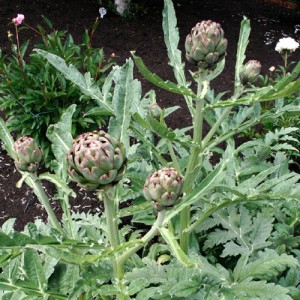Mulching Artichokes
 Question from Guy:
Question from Guy:
I watched your you-tube video on artichokes with interest. I live in CNY in the finger lakes region zone 5 I believe. I grew some artichokes from seed, this spring. One plant actually produced a flower, which I ate and enjoyed. the others have not produced a flower but plenty of foliage. our winters are reasonable cold. Would it be possible to to push the plants on the ground and mulch them over winter so the will grow again next year? we are deffinately having cooler weather already and I want to prepare them for the much colder weather, to come.
Answer from Pat:
Artichokes are native to the southern Mediterranean. They are not adapted to survive outdoors in Zone 5, a cold winter climate. If you wish you could try to protect it by cutting the top back to one foot as soon as the leaves go yellow and then covering the plant with a heavy layer of mulch, but I doubt it will work. The root is not hardy so it would freeze in the ground and then rot when the ground thaws. Another thing you could try is to cut off the foliage, dig up the roots and knock off all the soil then tie the roots together and hang them upside-down in your cellar for the winter. Plant the root again when the weather warms up in spring. I dreamed up this idea just now based on the fact that people can do this with geraniums. I doubt it will work with artichokes, but perhaps no one has ever tried it. It’s worth a try. It won’t be easy since artichokes have a big fleshy root—enormous is more like it—but due to the size of the root, it could perhaps survive.
My third option is probably the best and that is to bid goodbye and thanks to this year’s plant and put in another artichoke plant from a 4-inch size pot in spring as soon as you see them at your local nursery. If you want to grow a plant from seed yourself, you could plant the seeds in January and then plant them outdoors immediately after the last frost date in your area. The trick with artichokes is to grow them in well-drained soil, water deeply and often and also fertilize frequently. They are heavy feeders and most people starve them. If you take super good care of your plant you could grow a big, beefy one and might even have better luck next year than you did this year and you could enjoy artichokes as an annual plant every year in your garden. Plentiful water and fertilizer is the key. The Finger Lakes District is not too hot in summer so growing artichokes as an annual might be a viable option for you.
I was in the Adirondacks last June so I can imagine the lovely area where you live. Here where I live in California if I plant artichokes from 4-inch size on March first, I can get a huge harvest (one huge fruit, 4 pretty good size fruits, and 24 small ones) in early June. This makes me think you could bring your plant to harvest in three months from planting date by forcing it with water and fertilizer. Rainfall is good in your area, that might provide enough water. If the soil is soggy and drainage poor, plant in a raised bed.


Hi Pat, if it’s possible to amend your answer that would be helpful for those of us in the Northeast that want to grow artichokes and find your site. For artichokes to produce in a single season, they need to be vernalized (exposed to cold) to trick them into thinking they’ve gone through a winter. The standard advice in the northeast is to use Imperial Star, which has a shorter chilling period and then expose them to temps between 32 and 50 for about 8 weeks before setting them out. Also, I overwintered 2 artichokes outside in Zone 4b last winter by cutting them down to a stump and then covering with straw inside a blue apron box wrapper and box. The key is to keep them dry or they will rot as you indicate. One eventually died, I think from poor drainage but the other is going strong!
Finally, they can also be grown in large pots and moved inside for winter. Happy gardening!
Thank you so much for these helpful comments. I hope gardeners who want to grow artichokes in the Northeastern sections of the USA will read this and take heart.